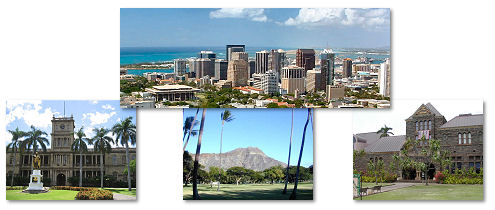
City Maps/Weather
| Fun City Facts Boeing's final assembly plant, the world's largest building, is located in Everett, Washington. The Space Needle, built in 1961 in Seattle, Washington is the first revolving restaurant. |
|
|
||
Honolulu, Hawaii
City History |
||
 It is not known when Honolulu was first settled by the original Polynesian migrants to the archipelago. Oral histories and artifacts indicate that there was a settlement where Honolulu now stands in the 12th century. However, after Kamehameha I conquered Oahu in the Battle of Nuuanu Pali, he moved his royal court from the Island of Hawaii to Waikiki in 1804. His court later relocated, in 1809, to what is now downtown Honolulu. Captain William Brown of England was the first foreigner to sail, in 1794, into what is now Honolulu Harbor. More foreign ships would follow, making the port of Honolulu a focal point for merchant ships traveling between North America and Asia. In 1845, Kamehameha III moved the permanent capital of the Hawaiian Kingdom from Lahaina on Maui to Honolulu. He and the kings that followed him transformed Honolulu into a modern capital, erecting buildings such as St. Andrew's Cathedral, Iolani Palace, and Aliiolani Hale. At the same time, Honolulu became the center of commerce in the Islands, with descendants of American missionaries establishing major businesses in downtown Honolulu. Despite the turbulent history of the late 19th century and early 20th century, which saw the overthrow of the Hawaiian monarchy, Hawaii's subsequent annexation by the United States, and the Japanese attack on Pearl Harbor, Honolulu would remain the capital, largest city, and main airport and seaport of the Hawaiian Islands. An economic and tourism boom following statehood brought rapid economic growth to Honolulu and Hawaii. Modern air travel would bring thousands, eventually millions (per annum) of visitors to the Islands. Today, Honolulu is a modern city with numerous high-rise buildings, and Waikiki is the center of the tourism industry in Hawaii, with thousands of hotel rooms. |
Historic Figures
browse cities | search | get listed | spotlight | about us | contact us | policies | partners
Copyright ©2024 www.ByCityLight.com - Page Design by Erik Schubach and Tristan Chambers